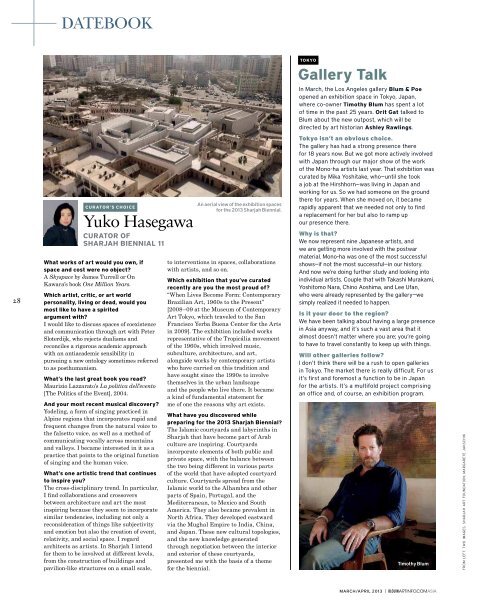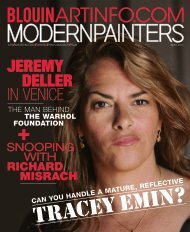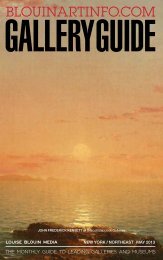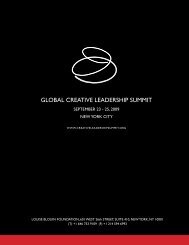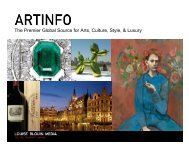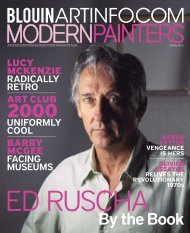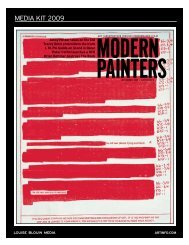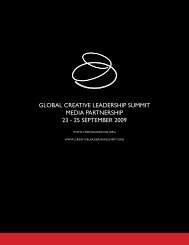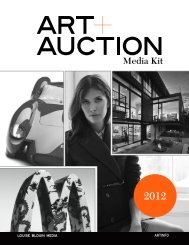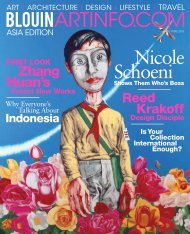Linke - Artinfo
Linke - Artinfo
Linke - Artinfo
You also want an ePaper? Increase the reach of your titles
YUMPU automatically turns print PDFs into web optimized ePapers that Google loves.
28<br />
datebook<br />
cuRATOR’S c h O ice<br />
Yuko Hasegawa<br />
cuRATOR Of<br />
ShARjAh BienniAl 11<br />
What works of art would you own, if<br />
space and cost were no object?<br />
A Skyspace by James Turrell or On<br />
Kawara’s book One Million Years.<br />
Which artist, critic, or art world<br />
personality, living or dead, would you<br />
most like to have a spirited<br />
argument with?<br />
I would like to discuss spaces of coexistence<br />
and communication through art with Peter<br />
Sloterdijk, who rejects dualisms and<br />
reconciles a rigorous academic approach<br />
with an antiacademic sensibility in<br />
pursuing a new ontology sometimes referred<br />
to as posthumanism.<br />
What’s the last great book you read?<br />
Maurizio Lazzarato’s La politica dell’evento<br />
[The Politics of the Event], 2004.<br />
And your most recent musical discovery?<br />
Yodeling, a form of singing practiced in<br />
Alpine regions that incorporates rapid and<br />
frequent changes from the natural voice to<br />
the falsetto voice, as well as a method of<br />
communicating vocally across mountains<br />
and valleys. I became interested in it as a<br />
practice that points to the original function<br />
of singing and the human voice.<br />
What’s one artistic trend that continues<br />
to inspire you?<br />
The cross-disciplinary trend. In particular,<br />
I find collaborations and crossovers<br />
between architecture and art the most<br />
inspiring because they seem to incorporate<br />
similar tendencies, including not only a<br />
reconsideration of things like subjectivity<br />
and emotion but also the creation of event,<br />
relativity, and social space. I regard<br />
architects as artists. In Sharjah I intend<br />
for them to be involved at different levels,<br />
from the construction of buildings and<br />
pavilion-like structures on a small scale,<br />
An aerial view of the exhibition spaces<br />
for the 2013 Sharjah Biennial.<br />
to interventions in spaces, collaborations<br />
with artists, and so on.<br />
Which exhibition that you’ve curated<br />
recently are you the most proud of?<br />
“When Lives Become Form: Contemporary<br />
Brazilian Art, 1960s to the Present”<br />
[2008–09 at the Museum of Contemporary<br />
Art Tokyo, which traveled to the San<br />
Francisco Yerba Buena Center for the Arts<br />
in 2009]. The exhibition included works<br />
representative of the Tropicália movement<br />
of the 1960s, which involved music,<br />
subculture, architecture, and art,<br />
alongside works by contemporary artists<br />
who have carried on this tradition and<br />
have sought since the 1990s to involve<br />
themselves in the urban landscape<br />
and the people who live there. It became<br />
a kind of fundamental statement for<br />
me of one the reasons why art exists.<br />
What have you discovered while<br />
preparing for the 2013 Sharjah Biennial?<br />
The Islamic courtyards and labyrinths in<br />
Sharjah that have become part of Arab<br />
culture are inspiring. Courtyards<br />
incorporate elements of both public and<br />
private space, with the balance between<br />
the two being different in various parts<br />
of the world that have adopted courtyard<br />
culture. Courtyards spread from the<br />
Islamic world to the Alhambra and other<br />
parts of Spain, Portugal, and the<br />
Mediterranean, to Mexico and South<br />
America. They also became prevalent in<br />
North Africa. They developed eastward<br />
via the Mughal Empire to India, China,<br />
and Japan. These new cultural topologies,<br />
and the new knowledge generated<br />
through negotiation between the interior<br />
and exterior of these courtyards,<br />
presented me with the basis of a theme<br />
for the biennial.<br />
TOkyO<br />
Gallery Talk<br />
In March, the Los Angeles gallery Blum & Poe<br />
opened an exhibition space in Tokyo, Japan,<br />
where co-owner Timothy Blum has spent a lot<br />
of time in the past 25 years. Orit Gat talked to<br />
Blum about the new outpost, which will be<br />
directed by art historian Ashley Rawlings.<br />
Tokyo isn’t an obvious choice.<br />
The gallery has had a strong presence there<br />
for 18 years now. But we got more actively involved<br />
with Japan through our major show of the work<br />
of the Mono-ha artists last year. That exhibition was<br />
curated by Mika Yoshitake, who—until she took<br />
a job at the Hirshhorn—was living in Japan and<br />
working for us. So we had someone on the ground<br />
there for years. When she moved on, it became<br />
rapidly apparent that we needed not only to find<br />
a replacement for her but also to ramp up<br />
our presence there.<br />
Why is that?<br />
We now represent nine Japanese artists, and<br />
we are getting more involved with the postwar<br />
material. Mono-ha was one of the most successful<br />
shows—if not the most successful—in our history.<br />
And now we’re doing further study and looking into<br />
individual artists. Couple that with Takashi Murakami,<br />
Yoshitomo Nara, Chino Aoshima, and Lee Ufan,<br />
who were already represented by the gallery—we<br />
simply realized it needed to happen.<br />
Is it your door to the region?<br />
We have been talking about having a large presence<br />
in Asia anyway, and it’s such a vast area that it<br />
almost doesn’t matter where you are; you’re going<br />
to have to travel constantly to keep up with things.<br />
Will other galleries follow?<br />
I don’t think there will be a rush to open galleries<br />
in Tokyo. The market there is really difficult. For us<br />
it’s first and foremost a function to be in Japan<br />
for the artists. It’s a multifold project comprising<br />
an office and, of course, an exhibition program.<br />
Timothy Blum<br />
March/april 2013 | Blouin<strong>Artinfo</strong>.comAsiA<br />
from left: two images, sharjah art foundation; margarete jakschik


